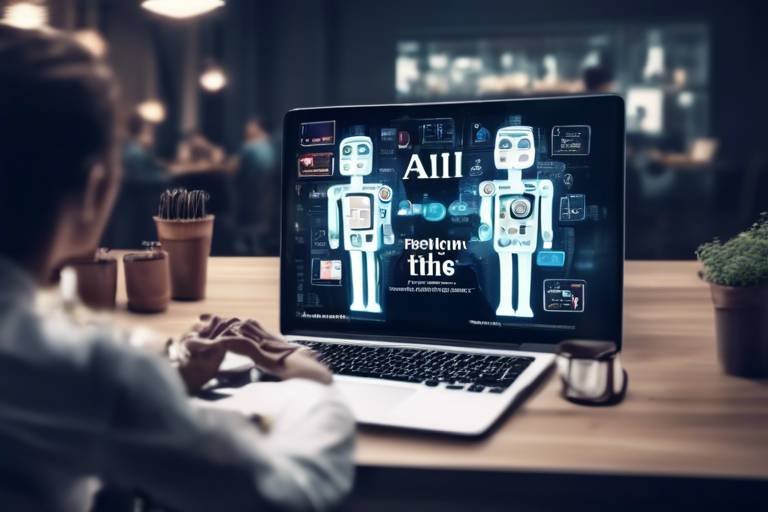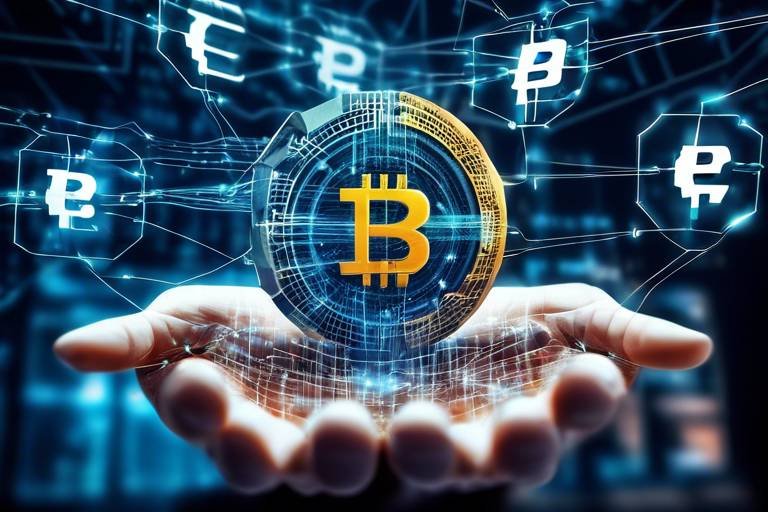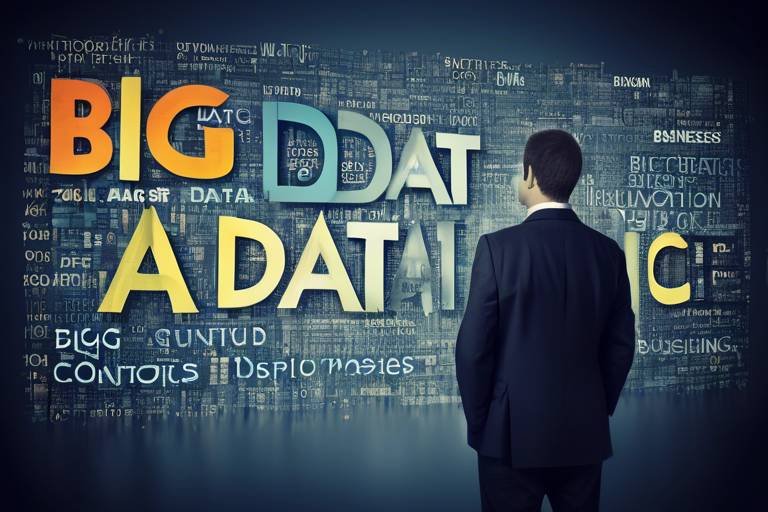Blockchain in Education: A New Era of Learning
In today's fast-paced world, the demand for transparency, security, and efficiency in education has never been more crucial. Enter blockchain technology, a revolutionary force that is reshaping the educational landscape. Imagine a world where your academic credentials are not only secure but also easily verifiable by employers and institutions alike. Sounds like a dream, right? Well, this dream is becoming a reality as blockchain technology paves the way for a new era of learning.
At its core, blockchain is a decentralized digital ledger that records transactions in a secure and transparent manner. This innovative technology is not just for cryptocurrencies; it has far-reaching implications for the education sector. By leveraging blockchain, educational institutions can enhance trust among students, teachers, and employers, ensuring that everyone's data is protected and verifiable.
So, what exactly does this mean for students and educators? For starters, blockchain can streamline administrative processes, making it easier to manage records and credentials. Picture this: instead of waiting weeks for a transcript to be processed, blockchain can facilitate instantaneous access to verified academic records. This not only saves time but also reduces the chances of errors or fraud in the record-keeping process.
Moreover, the impact of blockchain extends beyond just efficiency. It fosters a culture of accountability and integrity within educational institutions. With immutable records, every transaction is permanently recorded, making it nearly impossible to alter or forge academic achievements. This creates a more trustworthy environment for learners, employers, and institutions alike.
As we delve deeper into this topic, we will explore the various applications of blockchain in education, the benefits it brings, and the challenges that lie ahead. Buckle up, because the journey into the world of blockchain in education is just beginning!
Before we dive into the benefits and applications, let's take a moment to understand what blockchain really is. Imagine a digital notebook that is shared among various parties. Each time someone writes in this notebook, everyone else sees the update simultaneously. This is the essence of blockchain technology—a decentralized ledger that enhances transparency and trust.
In education, this means that all stakeholders, including students, teachers, and employers, can access and verify information without relying on a central authority. This decentralized approach not only enhances data integrity but also ensures that everyone has a say in the educational process.
Implementing blockchain in education offers a plethora of advantages that can revolutionize traditional systems. Here are some key benefits:
- Enhanced Security: With blockchain, student data is encrypted and stored securely, protecting it from unauthorized access.
- Improved Record-Keeping: The technology allows for real-time updates and easy access to academic records, reducing administrative burdens.
- Streamlined Processes: Institutions can issue and verify credentials without the need for intermediaries, saving time and resources.
One of the most significant advantages of blockchain in education is its ability to provide data security and privacy. Traditional educational systems often struggle with data breaches and unauthorized access to sensitive information. However, blockchain's encryption and decentralization offer a robust solution to these challenges.
Imagine a world where academic records cannot be tampered with. That’s the reality blockchain brings to the table with its immutable records. Once data is entered into the blockchain, it cannot be altered or deleted. This feature is crucial for preventing fraud and ensuring the authenticity of qualifications. Students can confidently present their credentials, knowing that they are backed by a secure and verifiable system.
Decentralized credentialing is another game-changer. It allows educational institutions to issue and verify credentials independently. This means that employers can easily check the authenticity of a candidate's qualifications without having to contact the educational institution directly. The verification process becomes seamless, saving time and reducing the risk of miscommunication.
While the advantages are compelling, implementing blockchain in education is not without its challenges. Issues such as scalability, regulatory concerns, and resistance to change can pose significant hurdles. However, with ongoing research and collaboration among institutions, these challenges can be addressed effectively.
To truly understand the impact of blockchain in education, let’s take a look at some real-world examples. Various universities are piloting blockchain initiatives to enhance administrative efficiency and improve the student experience. These innovative projects are paving the way for a more transparent and trustworthy educational landscape.
Several universities have embraced blockchain technology to streamline their operations. For instance, a notable initiative involves using blockchain to manage student records, allowing for instant access and verification. The results have been promising, with reduced administrative costs and increased student satisfaction.
Globally, the potential of blockchain in education is being explored in various countries. Collaborative efforts are underway to leverage this technology for educational advancements, showcasing how blockchain can transcend borders and create a more interconnected educational ecosystem.
Q1: What is blockchain technology?
A1: Blockchain is a decentralized digital ledger that records transactions securely and transparently, ensuring data integrity.
Q2: How can blockchain benefit education?
A2: Blockchain enhances security, improves record-keeping, and streamlines processes, making it easier for institutions to manage academic credentials.
Q3: Are there challenges in implementing blockchain in education?
A3: Yes, challenges include scalability, regulatory issues, and resistance to change, but these can be addressed through collaboration and research.
Q4: What are some real-world examples of blockchain in education?
A4: Several universities are piloting blockchain initiatives for managing student records and credentials, resulting in increased efficiency and student satisfaction.
As we move forward, the integration of blockchain technology in education promises to create a more secure, efficient, and transparent learning environment. The future of education is here, and it's built on the foundation of blockchain!

Understanding Blockchain Technology
At its core, blockchain technology is a decentralized digital ledger that records transactions in a secure and transparent manner. Imagine it as a chain of blocks, where each block contains a list of transactions. Once a block is filled with data, it is added to the chain in a way that is nearly impossible to alter. This structure is what makes blockchain so revolutionary, especially in the realm of education. By ensuring that every piece of data is verified and securely stored, blockchain fosters trust among all stakeholders in the educational process.
The fundamental principles of blockchain technology can be broken down into a few key components:
- Decentralization: Unlike traditional databases controlled by a single entity, blockchain operates on a network of computers (nodes) that share the same information. This means no single point of failure, making it incredibly resilient.
- Transparency: Every transaction recorded on the blockchain is visible to all participants in the network. This transparency helps build trust and accountability, as anyone can verify the data.
- Immutability: Once data is added to the blockchain, it cannot be changed or deleted. This feature is crucial for maintaining the integrity of academic records, as it prevents fraud and ensures authenticity.
In the context of education, these principles translate into a system where student records, credentials, and achievements are securely stored and easily accessible. Imagine a world where a student's academic history is not only accurate but also verifiable by employers and other educational institutions without the hassle of lengthy processes. This is the promise of blockchain technology in education.
Furthermore, the application of blockchain extends beyond just record-keeping. It can facilitate smart contracts, which are self-executing contracts with the terms of the agreement directly written into code. For instance, a smart contract could automatically verify and issue a diploma once a student has completed all necessary requirements, eliminating the need for manual verification processes. This not only speeds up the administrative tasks but also enhances the overall efficiency of educational institutions.
As we delve deeper into the implications of blockchain for education, it's essential to consider both the opportunities it presents and the challenges it poses. Understanding the technology is just the first step in leveraging its full potential to transform the educational landscape.

Benefits of Blockchain in Education
Implementing blockchain technology in education is not just a trend; it's a transformative movement that promises to revolutionize how we approach learning and credentialing. Imagine a world where your academic achievements are securely stored in a digital vault, accessible at any moment, and verifiable by anyone you choose. This is the kind of future blockchain offers, enhancing not only the security of records but also the overall efficiency of educational processes.
One of the most significant benefits of blockchain in education is its ability to enhance security. Traditional systems often rely on centralized databases, which can be vulnerable to hacks and data breaches. Blockchain, on the other hand, operates on a decentralized model, meaning that information is distributed across a network of computers. This makes it incredibly difficult for unauthorized users to tamper with data. For students, this means their personal information and academic records are safeguarded against identity theft and fraud.
Moreover, blockchain provides improved record-keeping. Consider the hassle of managing paper transcripts or the tedious process of verifying degrees with educational institutions. With blockchain, every transaction—be it a course completion, a degree awarded, or a credential issued—is recorded on an immutable ledger. This not only streamlines administrative tasks but also ensures that records are accurate and easily accessible. Imagine a future where employers can instantly verify a candidate's qualifications without the need for lengthy background checks. This is the efficiency that blockchain brings to the table.
Another remarkable aspect is the concept of decentralized credentialing. This allows educational institutions to issue and verify credentials independently, without the need for a central authority. For instance, when a student completes a course, a digital certificate can be issued and stored on the blockchain. This certificate can be shared with potential employers directly, eliminating the need for third-party verification. Such a system not only saves time but also fosters trust among employers, as they can verify the authenticity of credentials with just a few clicks.
To illustrate the benefits further, let’s look at a simple comparison:
| Traditional System | Blockchain System |
|---|---|
| Centralized data storage | Decentralized data storage |
| Vulnerable to data breaches | Enhanced security through encryption |
| Time-consuming verification processes | Instant verification of credentials |
| Risk of fraud in records | Immutable and verifiable records |
In addition to these benefits, blockchain can also promote greater transparency in educational institutions. Stakeholders, including students, parents, and employers, can have a clear view of the academic journey of a learner. This transparency fosters accountability among educational providers and ensures that students receive the quality of education they deserve.
However, while the benefits are substantial, it’s essential to recognize that the implementation of blockchain in education is still in its infancy. As we explore its potential, we must also address the challenges that come with it. But for now, the advantages of blockchain technology in education are clear and compelling, paving the way for a future where learning is more secure, efficient, and accessible.

Data Security and Privacy
In today's digital age, where data breaches and privacy concerns are rampant, the importance of data security and privacy in education cannot be overstated. Blockchain technology emerges as a beacon of hope, offering a robust framework that not only enhances the security of student data but also ensures that this information remains confidential and protected from unauthorized access. Imagine a world where your academic records are not just stored in a centralized database that could be hacked, but instead, they are securely encrypted and spread across a decentralized network. This is the promise of blockchain.
One of the most compelling features of blockchain is its use of encryption. Each piece of data is locked away in a cryptographic code that can only be accessed by individuals who possess the correct keys. This means that even if someone were to gain access to the network, they would be unable to read the data without the appropriate permissions. This level of security is particularly crucial for educational institutions, which handle sensitive information such as student grades, personal details, and financial records.
Moreover, the decentralized nature of blockchain technology significantly reduces the risk of a single point of failure. In traditional systems, if a central database is compromised, all data can be at risk. However, with blockchain, data is distributed across multiple nodes, making it virtually impossible for hackers to alter or steal information without being detected. This decentralized approach not only enhances security but also fosters trust among stakeholders, including students, parents, and educational institutions.
To further illustrate the impact of blockchain on data security and privacy in education, consider the following key points:
- Enhanced Data Integrity: Blockchain’s immutable nature ensures that once data is recorded, it cannot be altered or deleted. This feature is crucial for maintaining the integrity of academic records.
- Controlled Access: With blockchain, students can control who has access to their information. This means they can share their credentials with potential employers or institutions without fear of data misuse.
- Transparency and Accountability: Blockchain technology allows for transparent transactions that can be traced back to their source, ensuring accountability in the handling of personal data.
In summary, the integration of blockchain in education not only addresses the pressing issues of data security and privacy but also transforms the way institutions manage and protect sensitive information. By leveraging this innovative technology, educational organizations can create a safer, more secure environment for students to thrive. As we continue to explore the potential of blockchain, it becomes clear that the future of education may very well depend on our ability to harness its capabilities to protect and empower learners.

Immutable Records
The concept of is one of the most revolutionary aspects of blockchain technology, particularly in the realm of education. Imagine a world where your academic achievements are permanently etched into a digital ledger, impossible to alter or erase. This is not just a dream; it is the reality that blockchain brings to the table. By utilizing a decentralized system, educational institutions can create records that are both trustworthy and verifiable. This ensures that once a record is created—be it a degree, certificate, or transcript—it cannot be tampered with, providing an unprecedented level of security and authenticity.
In traditional educational systems, the risk of fraud is a significant concern. Students may present falsified documents to gain admission or secure employment, leading to a loss of trust among institutions and employers alike. However, with blockchain's immutable records, each credential is linked to a unique cryptographic hash. This hash acts like a digital fingerprint, making it easy to verify the authenticity of a document without the possibility of alteration. As a result, employers can confidently trust the qualifications of potential hires, knowing that the records are legitimate and have not been manipulated.
Furthermore, the implications of immutable records extend beyond just preventing fraud. They can also streamline administrative processes, reducing the time and resources spent on verifying credentials. Educational institutions can benefit from this efficiency in several ways:
- Reduced Verification Time: Employers can verify a candidate's qualifications in real-time, eliminating lengthy background checks.
- Cost Savings: Institutions save money on administrative tasks related to record-keeping and verification.
- Enhanced Trust: The transparency of blockchain fosters greater trust between students, institutions, and employers.
However, the journey towards implementing immutable records is not without its challenges. Institutions must invest in the necessary technology and training to ensure that staff are equipped to handle this new system. Additionally, there is a need for collaboration between various stakeholders to create a standardized approach to blockchain in education. As we move forward, it will be essential to address these challenges to fully harness the potential of immutable records in transforming educational practices.
Q: What are immutable records?
A: Immutable records refer to data entries on a blockchain that cannot be changed or deleted once they are created, ensuring the integrity and authenticity of the information.
Q: How do immutable records prevent fraud in education?
A: By using cryptographic hashes, blockchain ensures that academic records are unique and verifiable, making it nearly impossible to alter or forge credentials.
Q: What are the benefits of using blockchain for educational records?
A: Benefits include enhanced security, reduced verification time, cost savings, and increased trust among students, institutions, and employers.
Q: What challenges exist in implementing blockchain technology in education?
A: Challenges include the need for technological investment, staff training, and the establishment of standardized practices across institutions.

Decentralized Credentialing
Imagine a world where your educational credentials are not just pieces of paper, but secure, verifiable digital assets that you can carry in your pocket. This is the promise of powered by blockchain technology. In this new paradigm, educational institutions can issue digital diplomas and certificates directly onto a blockchain. This means that instead of relying on traditional methods of verification, employers and other educational entities can access a tamper-proof record of your achievements with just a few clicks.
The beauty of decentralized credentialing lies in its transparency and efficiency. When a university issues a degree on the blockchain, it creates a unique digital signature that is virtually impossible to forge. This not only protects the integrity of the educational system but also empowers students. They can easily share their credentials with potential employers or other institutions without the hassle of sending physical documents or waiting for verification processes that can take weeks or even months.
Furthermore, decentralized credentialing eliminates the need for a central authority to manage and verify educational records. This decentralized approach means that students have more control over their data. They can choose who to share their credentials with, enhancing their privacy. For example, if a student graduates from a university, they can store their degree on the blockchain and share it with prospective employers through a secure link, ensuring that their qualifications are both authentic and easily accessible.
To illustrate the impact of decentralized credentialing, consider the following table that outlines the traditional credentialing process compared to the blockchain-based approach:
| Aspect | Traditional Credentialing | Decentralized Credentialing |
|---|---|---|
| Verification Time | Weeks to Months | Instant |
| Fraud Risk | High | Minimal |
| Control Over Data | Institutional | Student |
| Cost of Verification | High | Low |
As we can see, decentralized credentialing not only streamlines the verification process but also significantly reduces the risk of fraud while empowering students to take charge of their own educational records. However, it's essential to recognize that this innovative approach is still in its infancy. Educational institutions and employers must adapt to this new system, which may require a shift in mindset and practices.
In conclusion, decentralized credentialing represents a significant leap forward in how we manage and verify educational qualifications. By leveraging blockchain technology, we can create a more secure, efficient, and student-centered approach to credentialing that benefits everyone involved. As we continue to explore the potential of blockchain in education, the future looks bright for learners and institutions alike.
- What is decentralized credentialing? Decentralized credentialing refers to the use of blockchain technology to issue and verify educational credentials, allowing for secure and tamper-proof records.
- How does it benefit students? It gives students control over their credentials, enables instant verification, and reduces the risk of fraud.
- Are there any challenges with decentralized credentialing? Yes, challenges include the need for institutions to adapt to new technologies and the potential for regulatory hurdles.
- Is decentralized credentialing widely adopted? While still emerging, several institutions are piloting blockchain initiatives to explore its benefits in credentialing.

Challenges of Implementing Blockchain
Implementing blockchain technology in education isn't all sunshine and rainbows. While the potential benefits are tantalizing, there are several challenges that institutions face when trying to integrate this innovative technology into their existing frameworks. One of the most significant hurdles is scalability. As more users join the network, the system's ability to process transactions can become strained. Imagine a busy highway during rush hour; if too many cars try to merge into a single lane, traffic slows down. Similarly, blockchain networks can face delays in processing data when overwhelmed. This is particularly concerning for educational institutions that require timely updates and access to records.
Another challenge is the regulatory landscape. Education is a heavily regulated sector, and introducing blockchain could lead to a complex web of compliance issues. Institutions must navigate various laws and regulations that govern data privacy, security, and accreditation. For example, how will student data be protected under GDPR or FERPA regulations? Institutions need to ensure that they are not only compliant but also transparent in their operations. This can be likened to walking a tightrope; one misstep could lead to significant penalties and loss of trust.
Furthermore, there is often a resistance to change from both educators and administrative staff. Many individuals are accustomed to traditional systems and may be hesitant to adopt new technologies. This reluctance can stem from a lack of understanding of blockchain's benefits or fear of the unknown. To overcome this barrier, institutions must invest in comprehensive training and awareness programs that highlight the advantages of blockchain. Think of it as introducing a new recipe to a family; it may take time for everyone to warm up to the idea, but with the right approach, they might just love it!
Moreover, the initial costs associated with implementing blockchain can be daunting. Setting up the necessary infrastructure, training staff, and ensuring ongoing support requires significant investment. Institutions must weigh these costs against the long-term benefits. A cost-benefit analysis can help in making informed decisions. Here’s a simplified table to illustrate this:
| Cost Factors | Benefits |
|---|---|
| Infrastructure Setup | Enhanced Security |
| Staff Training | Improved Record-Keeping |
| Maintenance Costs | Streamlined Processes |
Lastly, the technology itself is still evolving. Interoperability between different blockchain systems can be an issue. If various educational institutions adopt different blockchain platforms, sharing data and credentials can become a nightmare. It's like trying to communicate in different languages without a translator; the message can get lost or misinterpreted. Therefore, establishing common standards and protocols is crucial for the successful implementation of blockchain in education.
In summary, while the challenges of implementing blockchain in education are significant, they are not insurmountable. With careful planning, stakeholder engagement, and a willingness to adapt, educational institutions can harness the transformative power of blockchain technology. The journey may be complex, but the destination promises a more secure, efficient, and transparent educational landscape.
- What is blockchain technology? Blockchain is a decentralized digital ledger that securely records transactions across multiple computers.
- How can blockchain enhance data security in education? By utilizing encryption and decentralization, blockchain protects student data from unauthorized access.
- What are immutable records? Immutable records are unchangeable entries in a blockchain that ensure the authenticity of academic qualifications.
- What challenges do institutions face when implementing blockchain? Challenges include scalability, regulatory issues, resistance to change, initial costs, and interoperability.

Case Studies of Blockchain in Education
As we dive into the exciting world of blockchain in education, it's essential to look at real-world examples that showcase its transformative potential. Various educational institutions globally are experimenting with blockchain technology, paving the way for a more secure, transparent, and efficient learning environment. These case studies not only illustrate the practical applications of blockchain but also highlight the innovative spirit of the education sector.
One notable example comes from the University of Nicosia in Cyprus, which has taken significant strides in integrating blockchain into its educational framework. The university offers a Master's degree in Digital Currency, focusing on the implications of blockchain technology. By utilizing blockchain for academic records, the institution allows students to store and share their credentials securely and transparently. This initiative not only enhances the credibility of the qualifications but also empowers students by giving them control over their academic achievements.
Another compelling case is the MIT Media Lab, where researchers have developed a blockchain-based system for issuing and verifying digital diplomas. This project, known as the Blockcerts, allows graduates to receive a digital certificate that is easily verifiable by employers and educational institutions. The use of blockchain ensures that the certificates are tamper-proof, significantly reducing the risk of diploma fraud. As a result, employers can trust the authenticity of the credentials presented by candidates, streamlining the hiring process.
In addition to individual institutions, there are also collaborative efforts that illustrate the global reach of blockchain in education. For instance, the Open University in the UK has partnered with various organizations to explore the use of blockchain for lifelong learning records. This initiative aims to create a comprehensive and secure digital portfolio for learners, allowing them to showcase their skills and qualifications throughout their careers. By leveraging blockchain, the Open University is enhancing the credibility and accessibility of lifelong learning, making it easier for individuals to navigate their educational journeys.
To further illustrate the impact of blockchain in education, let’s take a look at a table summarizing some key initiatives:
| Institution | Project | Impact |
|---|---|---|
| University of Nicosia | Master's in Digital Currency | Secure storage and sharing of academic credentials |
| MIT Media Lab | Blockcerts | Tamper-proof digital diplomas |
| Open University | Lifelong Learning Records | Comprehensive digital portfolios for learners |
These examples showcase how blockchain technology is not just a buzzword but a practical solution that addresses long-standing challenges in the education sector. By enhancing security, improving record-keeping, and streamlining processes, blockchain is setting the stage for a new era of learning. As more institutions adopt this technology, we can expect a ripple effect that will revolutionize how education is perceived and delivered.
Q: What is blockchain technology?
A: Blockchain is a decentralized digital ledger that securely records transactions across multiple computers, ensuring that the data cannot be altered retroactively without the involvement of all parties.
Q: How does blockchain enhance security in education?
A: Blockchain enhances security by encrypting data and storing it in a decentralized manner, making it difficult for unauthorized users to access or manipulate sensitive information.
Q: Can blockchain help prevent diploma fraud?
A: Yes, blockchain creates immutable records of academic credentials, making it nearly impossible to forge diplomas and ensuring that employers can verify qualifications easily.
Q: What challenges do educational institutions face when implementing blockchain?
A: Challenges include scalability, regulatory compliance, and resistance to change within traditional educational frameworks.

University Initiatives
As the digital landscape evolves, universities around the globe are stepping up to integrate blockchain technology into their systems. These initiatives are not merely experimental; they are paving the way for a more secure, efficient, and transparent educational framework. For instance, institutions like the University of Nicosia have become pioneers in this field, offering blockchain-based courses and even issuing diplomas on the blockchain. This approach not only enhances the credibility of their qualifications but also makes it easier for employers to verify educational credentials—no more waiting for paper transcripts to arrive in the mail!
Moreover, the University of Melbourne is exploring the use of blockchain to streamline administrative processes. They are working on a project that focuses on decentralized record-keeping. By using blockchain, they aim to create a system where student records are securely stored and easily accessible, thereby reducing the administrative burden on staff and allowing students to have more control over their own educational data. Imagine a world where you can carry your academic history in your pocket, and share it with potential employers at the click of a button!
Not to be left behind, universities in Asia are also taking significant steps. In Japan, the National University of Singapore has launched a blockchain initiative to enhance student engagement and participation in academic activities. The university is implementing a system where students can earn tokens for attending classes, participating in discussions, and completing assignments. These tokens can then be redeemed for various rewards, effectively gamifying the learning experience and encouraging students to be more active participants in their education.
To give you a clearer picture of the diverse initiatives, here’s a brief overview of some notable university projects:
| University | Initiative | Impact |
|---|---|---|
| University of Nicosia | Blockchain-based diplomas | Enhanced verification process for employers |
| University of Melbourne | Decentralized record-keeping | Reduced administrative burden |
| National University of Singapore | Token reward system | Increased student engagement |
These initiatives are just the tip of the iceberg. As more universities recognize the potential of blockchain, we can expect a wave of innovation that will reshape how we view education. The future may hold possibilities such as smart contracts that automatically grant degrees based on completed coursework, or systems that allow for real-time tracking of student progress. The implications are vast, and the excitement surrounding these projects is palpable.
Q: What is the main advantage of blockchain in education?
A: The main advantage is enhanced security and transparency in record-keeping, which helps prevent fraud and ensures the authenticity of academic credentials.
Q: Are there any challenges to implementing blockchain in universities?
A: Yes, challenges include scalability issues, regulatory concerns, and resistance to change from traditional educational practices.
Q: How can students benefit from blockchain technology?
A: Students can benefit by having secure access to their academic records, making it easier to share credentials with employers, and potentially earning rewards for academic engagement.

Global Perspectives
As we look beyond borders, the application of blockchain technology in education is gaining traction on a global scale. Countries from various continents are exploring innovative ways to integrate blockchain into their educational frameworks, each with unique challenges and opportunities. For instance, in Europe, several universities have initiated pilot projects aimed at enhancing the transparency and security of academic records. These initiatives not only aim to streamline administrative processes but also to build trust among students and employers alike.
In Asia, countries like India and Singapore are leading the charge by implementing blockchain solutions to tackle issues such as credential verification and student data privacy. The Indian government has launched initiatives that leverage blockchain to create a secure, tamper-proof system for academic records, making it easier for students to share their qualifications with potential employers. Meanwhile, Singapore's educational institutions are collaborating with tech companies to develop blockchain-based platforms that facilitate lifelong learning and skills verification, ensuring that the workforce remains agile and competitive.
Across the Atlantic, the United States is witnessing a surge in blockchain projects within higher education. Universities are experimenting with decentralized credentialing systems that allow students to own and manage their academic records. This not only empowers learners but also simplifies the verification process for employers, reducing the time and resources spent on background checks. Furthermore, partnerships between educational institutions and blockchain startups are blossoming, paving the way for innovative solutions that address long-standing issues in the academic landscape.
To illustrate the global landscape of blockchain in education, consider the following table that highlights various initiatives across different countries:
| Country | Initiative | Focus Area |
|---|---|---|
| India | Blockchain for Education | Credential Verification |
| Singapore | SkillsFuture Initiative | Lifelong Learning |
| United States | Blockchain Credentialing | Decentralized Record Management |
| Estonia | e-Residency Program | Digital Identity for Students |
In addition to these national efforts, international collaborations are emerging to harness the full potential of blockchain technology in education. Organizations like the World Economic Forum and UNESCO are actively researching and promoting blockchain solutions, aiming to create a unified framework that can be adopted globally. These collaborations not only foster innovation but also encourage knowledge sharing among nations, ensuring that best practices are disseminated and adapted to local contexts.
In conclusion, the global perspective on blockchain in education reveals a dynamic landscape filled with promise and potential. As countries continue to explore and implement blockchain solutions, we can anticipate a future where education is more secure, transparent, and accessible to all. The journey may be fraught with challenges, but the collective efforts of educational institutions, governments, and technology providers are paving the way for a transformative era in learning.
- What is blockchain technology? Blockchain is a decentralized digital ledger that securely records transactions across multiple computers, ensuring that the data is tamper-proof and transparent.
- How can blockchain enhance education? Blockchain can improve data security, streamline administrative processes, and create immutable academic records, thus enhancing trust and efficiency in educational systems.
- What are the challenges of implementing blockchain in education? Some challenges include scalability, regulatory issues, and resistance to change from traditional educational institutions.
- Are there real-world examples of blockchain in education? Yes, several universities and organizations worldwide are piloting blockchain initiatives to enhance credential verification and administrative efficiency.
Frequently Asked Questions
- What is blockchain technology?
Blockchain technology is a decentralized digital ledger that securely records transactions across multiple computers. This means that once a transaction is recorded, it cannot be altered retroactively, ensuring data integrity and trust among users.
- How does blockchain enhance education?
Blockchain enhances education by providing enhanced security for student data, improving record-keeping, and streamlining administrative processes. This technology can revolutionize traditional educational systems by making them more transparent and efficient.
- What are immutable records in blockchain?
Immutable records refer to the unchangeable nature of data stored on a blockchain. Once academic records are created, they cannot be modified or deleted, which helps prevent fraud and ensures the authenticity of qualifications.
- How does blockchain ensure data security and privacy?
Blockchain ensures data security and privacy through encryption and decentralization. This means that student data is stored across a network rather than in a single location, making it less vulnerable to unauthorized access and breaches.
- What is decentralized credentialing?
Decentralized credentialing allows educational institutions to issue and verify credentials independently using blockchain. This simplifies the verification process for employers and other educational institutions, making it faster and more reliable.
- What challenges does blockchain face in education?
Implementing blockchain in education comes with challenges such as scalability, regulatory issues, and resistance to change from traditional practices. Addressing these obstacles is crucial for the successful integration of blockchain technology in educational systems.
- Are there examples of blockchain being used in education?
Yes, several universities and educational institutions are piloting blockchain initiatives. These projects aim to enhance administrative efficiency, improve student experiences, and ensure the security of academic records.
- How is the global perspective on blockchain in education?
Globally, there are various efforts and collaborations aimed at leveraging blockchain for educational advancements. Countries around the world are exploring how this technology can improve learning environments and administrative processes.



















